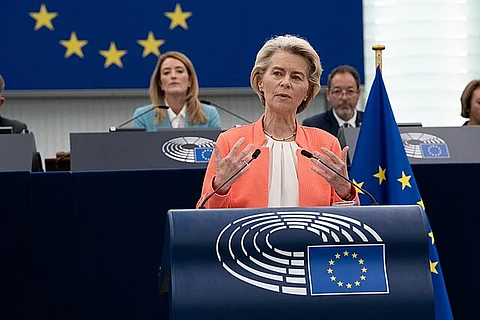

The European Union (EU) has positioned itself as a global leader in climate action, setting ambitious targets to reduce greenhouse gas (GHG) emissions and achieve carbon neutrality by 2050. These efforts are aligned with the Paris Agreement, which aims to limit global temperature increases to well below 2°C above pre-industrial levels. At the heart of the EU’s decarbonization strategy is the EU Emissions Trading System (EU ETS), launched in 2005. As the world’s first major carbon market, the EU ETS remains the largest of its kind, covering a significant share of the bloc’s emissions.
The EU ETS is a cap-and-trade system that applies to more than 11,000 power stations, industrial plants, and airlines operating within the European Economic Area. The system sets a cap on the total amount of carbon dioxide (CO₂), nitrous oxide (N₂O), and perfluorocarbons (PFCs) that can be emitted by regulated entities. This cap is reduced each year, ensuring a gradual decrease in emissions. By the end of Phase III (2013–2020), the cap aimed for emissions to be 21% lower than 2005 levels; by 2030, under Phase IV, the target is a reduction of at least 43% compared to 2005. Companies receive or purchase emission allowances, each permitting the holder to emit one tonne of CO₂-equivalent. Firms that reduce their emissions can sell excess allowances, while those exceeding their limits must buy additional allowances or face substantial fines. The supply and demand for these allowances determine the carbon price, theoretically ensuring that emissions are reduced at the lowest possible cost.
Despite its innovative design, the EU ETS has faced significant challenges. The global financial crisis of 2008–2009 led to a sharp decline in industrial activity and, consequently, lower emissions. This, combined with an influx of international credits and the success of national renewable energy policies, created a surplus of allowances and suppressed carbon prices for several years. Low prices, in turn, diminished the incentive for companies to invest in low-carbon technologies. To address these imbalances, the EU implemented several reforms. “Backloading” measures temporarily withheld allowances from the market, while the introduction of the Market Stability Reserve (MSR) in 2019 aimed to automatically adjust the supply of allowances in response to market surpluses or shortages. Phase IV reforms have further tightened the cap and enhanced mechanisms to support low-carbon innovation.
A growing body of empirical research has examined the effectiveness of the EU ETS in driving low-carbon technological change. Most studies find that the system has had a positive effect on research and development (R&D) and patenting activity related to low-carbon technologies. For example, regulated firms have increased investments in innovation, particularly in sectors such as energy and heavy industry. However, evidence for the widespread adoption of low-carbon technologies-such as the deployment of carbon capture and storage (CCS) or advanced renewable energy systems-is less robust. Many firms have focused on incremental improvements, such as energy efficiency and fuel switching, rather than transformative technological shifts. This may be due in part to the relatively low carbon prices during much of the EU ETS’s history, which limited the financial incentive for large-scale investments.
The method of allocating emission allowances has significantly influenced firms’ behavior. In the first two trading periods, most allowances were distributed for free based on historical emissions-a process known as “grandfathering.” This approach often weakened the incentive to invest in low-carbon technologies, as firms did not fully internalize the opportunity cost of using free allowances. In the electricity sector, allocation rules for new entrants further diluted the system’s effectiveness.
Phase III introduced a shift toward auctioning and benchmarking, which increased the cost of emitting and strengthened incentives for low-carbon investment. However, the impact of these changes was partially offset by the persistence of low allowance prices until the late 2010s.
Concerns about the potential loss of competitiveness and the risk of “carbon leakage”-whereby companies relocate production to countries with less stringent climate policies-led to continued free allocation for sectors deemed at risk. While this approach aimed to protect European industry, it also enabled some firms, particularly in the power sector, to reap windfall profits by passing on the notional cost of free allowances to consumers. Empirical studies suggest that, at least during the first two phases of the EU ETS, there was little evidence that the system negatively affected the competitiveness of regulated firms. Nonetheless, the issue remains a focal point of policy debates, especially as the EU considers further tightening the cap and reducing free allocation in future phases.
Since 2018, a series of reforms-including a more stringent cap, the operationalization of the MSR, and expanded funding mechanisms-have contributed to a sustained recovery in carbon prices. The Innovation Fund and the Modernization Fund, established under Phase IV, provide substantial financial support for the demonstration and deployment of breakthrough low-carbon technologies. The Innovation Fund, in particular, has a significantly larger budget than its predecessor, the NER300 program, and is expected to play a pivotal role in accelerating the commercialization of advanced solutions. Higher carbon prices, combined with reduced free allocation, are anticipated to strengthen the business case for investment in low-carbon technologies across the EU. These developments are expected to drive both incremental and transformative changes in sectors ranging from power generation to heavy industry.
Despite the wealth of research on the EU ETS, important gaps remain. There is a lack of recent empirical studies covering the latest trading periods, particularly since the start of Phase III. Sector-specific and firm-level analyses are also limited, making it difficult to draw definitive conclusions about the system’s effectiveness in different contexts. As the EU ETS continues to evolve, ongoing research will be essential to assess its impact and inform future policy design.